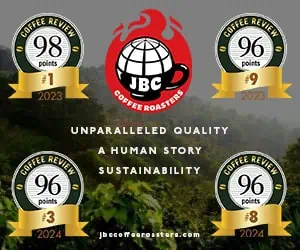However closely Caribbean coffees resemble one another in their full, rounded coastal flavor profiles, their individual stories are quite different. The Blue Mountain coffees of Jamaica are among the world’s most expensive, sought after by price-is-no-object romantics, while resented by many coffee professionals for their high price. The Yauco coffees of Puerto Rico represent a successful revival of an origin famous in the 19th and early 20th centuries, but long unavailable owing to high labor costs and other problems. Puerto Rico Yauco is also an expensive coffee, though not nearly so as Blue Mountain. Haiti is another famous gourmet coffee of the 19th century now undergoing a revival, in this case a revival crucial to the economic and environmental recovery of Haiti from the destruction caused by recent political disorders. Finally, the Dominican Republic, which shares the island of Hispaniola with Haiti, produces a variety of coffees that are little-known and perhaps under-appreciated.
How do coffees from these four origins match up with one another, and by implication, with similar coffees from other parts of the world? For this cupping Coffee Review obtained samples of twelve coffees, five from Jamaica, four from the Dominican Republic, two from Puerto Rico, and one from Haiti. Eight members of our panel reported on the samples.
For this particular cupping the usual caveat should be boldfaced in red: This is one year, one crop, one set of samples; the results of a single cupping may be interesting but hardly conclusive. Keep an open mind and a fresh palate.
I’ve tasted far better Puerto Rico Yaucos than the samples in this cupping, for example, including some from last year’s crop. The Haiti coffee is a relatively new experiment. Two of the Jamaica coffees are bulked coffees, meaning they were marketed by the mill at which they were wet-processed rather than by individual farm or estate. Other lots from the same mill may be much better than the two we happened to obtain. And so on.
Also keep in mind that North-American coffee professionals tend to favor bold, big coffees alive with the dry sensation called acidity. Neither boldness nor intense acidity are virtues of Caribbean coffees, which, like most grown in areas subject to coastal weather, are at best full, fragrant and balanced rather than decisive and authoritative. Some of our panelists (by their own admission) are unable to muster much genuine enthusiasm for gentler coastal coffees from origins like Hawaii and the Caribbean. If we were to mount a panel of European cuppers, who historically have been much more partial to soft-profile, balanced coffees than Americans, we might see different results.
That having been said, these Caribbean coffees as a group elicited about the same average rating as did two other origins with understated acidity and generally soft profile we cupped in recent months, the fancy Brazils and El Salvadors. This month’s Caribbean coffees averaged 76. The fancy Brazils cupped in February 1998 averaged 75; the El Salvadors in September 1997 74+. So we could say the Caribbeans prevailed by a nose, or by a bean. However, the Hawaii Konas I reported on two months ago averaged 80, and Konas are a coffee with virtues very similar to the best Caribbean coffees: gently complex, complete, subtly fragrant.
In a face-off of the world’s two most highest-priced coffees, Konas and Jamaica Blue Mountains, the Konas also prevailed, with an average rating 80 to a 77 for the Blue Mountains.
I suspect, reading between the lines of the cupping forms, that the Konas rated higher than any of the other origins the panel has cupped so far, including the Jamaicas, because they were processed by traditional methods with great care. Not one of the Konas displayed anything close to a processing or drying fault. They were all produced by small farms and mills owned by hands-on proprietors who fussed over every bean of their production from picking through pulping, fermenting and drying. The two Blue Mountain samples that came from a farm operated by a similarly obsessive (if charming) proprietor, Old Tavern Estate, elicited a quite respectable rating, one that would have placed these coffees among the leaders of the Kona cupping. It may be that things are going slightly wrong at the two mills that supplied the other two Blue Mountains in this month’s cupping: the Wallenford and the Mavis Bank. The Wallenford sample tasted as though it had been scrubbed into lifelessness by aqua-pulping equipment; the Mavis Bank may have been tainted by minor sloppiness marring an otherwise sound traditional wet-processing.
Puerto Rico’s Yauco Selecto, often a splendid coffee, disappointed here. I have to assume this is a bad year for Puerto Rico’s Yauco Selecto, since in this past I have tasted impressively balanced, complete samples from this origin, whereas the samples in this month’s cupping (as the panel almost unanimously recognized) were cleanly prepared but a bit underpowered and uninspiring.
The ratings for the Dominican coffees could be taken as mild support for those who claim that this origin is overlooked. I liked the Montanas Cresta very much, although the panel, by a couple of points, preferred the Rey Mezzanotte. One of the Dominican samples was clearly defective, and at least two, perhaps all, of the remaining three displayed shadow taints. Judging from this small sampling, the Dominican growers, like the wet-mill operators in Jamaica, would be well-served to review and fine-tune their procedures.











